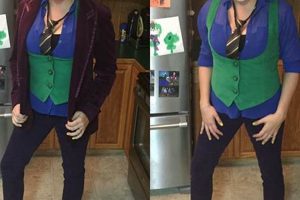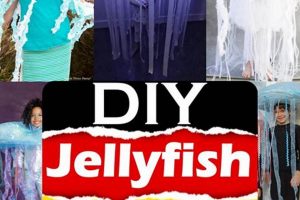The creation of a homemade death figure attire allows individuals to craft a personalized representation of this iconic character. This typically involves assembling dark, flowing garments, fashioning a symbolic scythe, and potentially designing a haunting mask or makeup to complete the spectral aesthetic. For instance, individuals might use inexpensive fabric to sew a hooded cloak and utilize PVC pipe to construct a lightweight scythe.
Constructing such an outfit offers significant advantages, including cost savings compared to purchasing pre-made costumes. Furthermore, it encourages creativity and allows for a unique and customized final product that reflects the wearer’s individual interpretation. Historically, the figure of death has been depicted in various forms across cultures, and creating a personalized representation can be seen as a continuation of this long-standing artistic and symbolic tradition.
The subsequent discussion will delve into various techniques for assembling the key components of this spectral attire, providing detailed instructions and material suggestions to facilitate a successful and memorable creation. Sections will cover cloak construction, scythe fabrication, and mask/makeup design, empowering individuals to craft their own chilling representation.
Essential Considerations for Crafting a Spectral Attire
The following guidelines offer practical advice for individuals undertaking the creation of a homemade death figure attire. Adherence to these suggestions can improve the quality, durability, and overall impact of the final product.
Tip 1: Fabric Selection is Crucial. Opt for dark, heavyweight fabrics such as broadcloth or linen to provide a realistic drape and avoid a flimsy appearance. Ensure the chosen material is opaque to prevent undergarments from being visible.
Tip 2: Prioritize Scythe Construction Safety. When fabricating the scythe, select lightweight yet sturdy materials such as PVC pipe or thin wood. Thoroughly sand any sharp edges and avoid the use of metal blades to prevent potential injuries.
Tip 3: Mask or Makeup Application Requires Planning. If employing makeup, conduct a patch test 24 hours prior to application to identify potential allergic reactions. For masks, ensure adequate ventilation and a secure fit to prevent discomfort or restricted breathing.
Tip 4: Cloak Length Should Be Carefully Considered. Measure the wearer’s height and adjust the cloak length accordingly. A cloak that is too long presents a tripping hazard, while a cloak that is too short detracts from the overall effect.
Tip 5: Emphasize Weather Resistance. If the attire is intended for outdoor use, consider applying a water-repellent treatment to the fabric. This will protect against dampness and ensure the costume remains presentable in inclement weather.
Tip 6: Attention to Detail Enhances Realism. Incorporate subtle details such as tattered edges on the cloak or weathering effects on the scythe to enhance the overall authenticity of the portrayal.
Tip 7: Prioritize Comfort. Ensure the attire allows for a full range of motion and does not restrict breathing or vision. The ability to move freely and comfortably is essential for a positive experience.
By implementing these suggestions, individuals can create a more effective and safer spectral attire, enhancing the overall impact and enjoyment of the final result.
The subsequent section will conclude this exploration by addressing common pitfalls and offering solutions to ensure a successful crafting experience.
1. Fabric Drape
Fabric drape exerts a significant influence on the visual impact of a homemade death figure attire. It is a primary determinant of how the costume’s silhouette is perceived. A fabric possessing favorable drape characteristics, such as flowing and folding naturally, creates a more convincing and aesthetically pleasing representation of the spectral figure. Conversely, a fabric with poor drape, tending to be stiff or ungainly, can diminish the overall effectiveness of the costume, resulting in an unconvincing or even comical appearance. The selection of appropriate fabric is therefore paramount to achieving a desired level of realism in this context. For example, using a heavy, matte jersey knit will result in a far superior drape compared to a starched cotton broadcloth.
The implications of fabric drape extend beyond mere aesthetics. A well-draped garment can enhance the illusion of movement and ethereality, contributing to a more dynamic and impactful presence. This is particularly relevant for performances or events where the wearer is moving, as the fabric’s flow accentuates gestures and amplifies the overall effect. Furthermore, consideration of drape properties can mitigate practical challenges. A fabric with good drape is less likely to wrinkle excessively or cling uncomfortably, thereby improving the wearer’s comfort and maintaining the costume’s visual integrity throughout prolonged use.
In summary, the relationship between fabric drape and the success of a homemade death figure attire is direct and consequential. Fabric drape significantly influences the perceived realism, enhances movement, and affects the practical aspects of comfort and maintenance. Careful fabric selection, prioritizing drape properties, is a crucial step in creating an effective and visually compelling representation of the spectral figure, minimizing the likelihood of an unconvincing or uncomfortable final product. The challenge lies in balancing desired drape with other factors such as cost, durability, and availability.
2. Scythe Realism
Scythe realism directly impacts the effectiveness of a homemade death figure attire. A poorly constructed or unrealistic scythe diminishes the overall impact of the costume, regardless of the quality of other elements. The scythe, as a recognizable symbol of death, serves as a focal point. Its authenticity, therefore, dictates how convincingly the wearer embodies the intended character. For example, a scythe crafted from flimsy materials or displaying an obviously artificial appearance detracts significantly from the intended visual effect. Conversely, a well-crafted scythe, incorporating details such as a weathered finish or realistic blade shape, enhances the costume’s credibility and contributes to a more compelling and unsettling portrayal. The cause-and-effect relationship is clear: scythe realism directly influences the audience’s perception of the costume as a whole.
Practical applications of this understanding are evident in various crafting techniques. Individuals constructing homemade death figure attire should prioritize material selection and fabrication methods that enhance the scythe’s realism. This includes utilizing sturdy materials such as wood or reinforced PVC pipe for the handle and carefully shaping the blade to resemble a genuine reaping tool. Paint
ing techniques can be employed to simulate weathering and age, further enhancing the scythe’s authenticity. Examples include dry brushing to create a worn appearance or applying metallic paint to mimic the look of sharpened steel. Furthermore, attention to detail, such as incorporating realistic textures or adding faux rust, can significantly improve the overall impression. Costumes incorporating these techniques consistently present a more convincing and impactful portrayal of the intended character.
In summary, scythe realism is a critical component of a successful homemade death figure attire. Its influence extends beyond mere aesthetics, affecting the overall credibility and impact of the costume. By prioritizing realistic construction and incorporating appropriate details, individuals can significantly enhance the effectiveness of their creations. However, achieving this realism presents challenges, including sourcing suitable materials and mastering relevant crafting techniques. Nevertheless, the investment in these areas is essential for creating a truly compelling and authentic representation of the iconic figure of death.
3. Hood Shape
The hood’s shape in a homemade death figure attire significantly influences the costume’s overall effectiveness and visual impact. A well-designed hood contributes to the character’s mystique and anonymity, while a poorly shaped hood can detract from the intended effect. The causal relationship is direct: the hood’s form affects the perceived credibility of the entire costume. For instance, a hood that is too small or fits awkwardly disrupts the intended silhouette, diminishing the menacing impression. Conversely, a generously sized hood that drapes appropriately creates shadows and obscures the face, enhancing the figure’s spectral nature. The hoods shape, therefore, is not merely a superficial detail but a crucial element in conveying the character’s essence.
Practical application of this understanding is evident in design choices. Individuals crafting death figure attire should prioritize the hood’s pattern and construction. Considerations include the hood’s depth, width, and the shape of the opening around the face. A deeper hood creates more pronounced shadows, while a wider hood allows for greater draping. The facial opening can be shaped to accentuate the eyes, drawing attention to the wearer’s gaze and intensifying the overall effect. Examples include employing a pointed or angular hood design to create a more dramatic silhouette or using a cowl-shaped hood to frame the face and add a sense of mystery. These design choices, when carefully executed, contribute to a more compelling and visually striking costume.
In summary, the hood’s shape is an indispensable aspect of a successful homemade death figure attire. It directly impacts the costume’s visual credibility and contributes to the overall impression of mystery and menace. Challenges in achieving an effective hood shape include accurately drafting patterns and selecting appropriate fabrics. Nevertheless, attention to these details is essential for creating a truly impactful representation of the iconic figure. The relationship between hood shape and overall costume effect is undeniable, highlighting the importance of careful design and construction.
4. Mask Details
Mask details are intrinsically linked to the overall success of a homemade death figure attire. The face covering, be it a fabricated mask or applied makeup, becomes a focal point, directly influencing the audience’s perception of the costume’s authenticity. A poorly executed mask detracts from the intended effect, regardless of the quality of other costume components. The mask serves as the embodiment of the character’s anonymity and spectral nature; its design therefore dictates the perceived level of menace and dread. A mask lacking detail, exhibiting an unnatural texture, or possessing an ill-fitting shape disrupts the illusion, resulting in an unconvincing portrayal. Conversely, a meticulously crafted mask, incorporating elements such as sunken eyes, skeletal features, or an expression of haunting detachment, enhances the costume’s impact, contributing to a more believable and chilling representation. The quality of mask details directly causes a corresponding reaction in the viewer’s perception of the entire costume.
The practical application of this principle is evident in the diverse range of mask-making techniques employed. Individuals creating death figure attire often prioritize the use of high-quality materials such as latex or foam for mask construction. They may then utilize sculpting tools to create realistic facial features, employing techniques such as shading and highlighting to accentuate depth and texture. Makeup artists, alternatively, may employ skills in contouring and highlighting to simulate skeletal structure or create an appearance of decay. For example, layering different shades of grey and black can effectively mimic the gaunt and hollowed features associated with death. Furthermore, details such as realistic-looking teeth or artificial shadows around the eyes can greatly enhance the mask’s overall effect. Each deliberate design choice, each carefully applied stroke, serves to elevate the mask from a mere covering to a crucial component that defines the character’s presence.
In summary, the nuanced details incorporated into a death figure mask are indispensable to the success of a homemade costume. These details have direct control over how the costume is perceived. Challenges in achieving realistic mask effects include mastering relevant sculpting and makeup techniques, and acquiring appropriate materials. Yet, the effort invested in crafting a compelling mask yields a correspondingly significant return in terms of the costume’s overall impact. The meticulous attention to mask details is vital for creating a truly convincing and memorable representation of the grim reaper.
5. Overall Darkness
The overall darkness is paramount in creating a convincing homemade death figure attire. This characteristic is not merely an aesthetic preference but a fundamental component intrinsically linked to the archetype of the Grim Reaper. The deliberate use of dark hues, particularly blacks, grays, and deep purples, reinforces the association with death, decay, and the unknown. A costume lacking sufficient darkness loses its thematic resonance, appearing less menacing and failing to evoke the desired sense of dread. For instance, a death figure attire constructed with light-colored fabrics, even with accurate detailing in other areas, diminishes the intended impact. The principle of cause and effect is clear: a darker color palette elicits a stronger emotional response aligned with the character’s symbolic representation.
The practical application of this understanding is evident in material selection and design choices. Costumers constructing a homemade death figure attire often prioritize dark, heavyweight fabrics such as broadcloth, velvet, or linen, not only for their draping qualities but also for their ability to absorb light and enhance the overall darkness. Furthermore, they may employ techniques such as layering dark fabrics or incorporating shadows and shading to create a more three-dimensional and visually imposing effect. For makeup o
r mask design, the strategic use of black and grey tones is essential for creating a skeletal or gaunt appearance, further emphasizing the theme of death and decay. Effective use of “Overall Darkness” can be readily observed in professional-grade costumes. A deep, dark and quality fabric, and an extra layer of makeup is what set apart a commercial quality grim reaper vs. a cheap one that often only use face paint for makeup.
In summary, the overall darkness is not a superficial attribute of a death figure attire but an essential element directly influencing its effectiveness. Challenges in achieving this characteristic include sourcing appropriate materials and mastering techniques for creating depth and shadow. However, meticulous attention to the darkness of the costume is essential for creating a truly convincing and memorable portrayal of the Grim Reaper, contributing significantly to the desired emotional response and thematic impact. Achieving the correct shade of darkness can often be the defining factor that separates a mediocre costume from an exceptional one.
6. Movement Range
The practical consideration of movement range holds significant importance in the design and construction of a homemade death figure attire. It directly affects the wearer’s ability to perform actions and interact with the environment while maintaining the illusion of the character. The limitations or enhancements provided by the costume’s design can drastically alter the wearer’s experience and the overall impact of the portrayal. Understanding these factors is crucial for crafting a successful and functional homemade attire.
- Cloak Length and Gait
The length of the cloak, a defining feature of the attire, directly impacts the wearer’s gait. An excessively long cloak can impede movement, creating a tripping hazard and hindering the ability to navigate crowded environments. Conversely, a cloak that is too short undermines the desired aesthetic. A properly adjusted cloak length allows for a fluid and natural gait, enhancing the overall spectral presence. For instance, a cloak extending just above the ground minimizes obstruction while maintaining a flowing silhouette.
- Scythe Weight and Maneuverability
The weight and design of the scythe, a symbolic attribute, influences maneuverability. A scythe constructed from heavy materials restricts movement and makes it difficult to perform actions such as gesturing or posing. A lightweight scythe, crafted from materials such as PVC pipe, allows for greater freedom of movement and enhances the wearer’s ability to project the character’s persona. The handle length also impacts reach and control. For example, a scythe with a counterbalance point allows for better control of the weapon.
- Mask Design and Visibility
The design of the mask, an integral component of anonymity, can restrict visibility, which subsequently affects movement. Masks with limited eye openings or obscured peripheral vision impair spatial awareness, increasing the risk of collisions and hindering navigation. A mask design that prioritizes visibility, such as a mesh-covered face or strategically placed eyeholes, improves movement range and enhances safety. For example, some masks use a transparent material that allow for full visibility without ruining the effect.
- Arm and Shoulder Restriction
The construction of the sleeves and shoulders on the robe can impact arm and shoulder mobility. Tight-fitting sleeves or restrictive shoulder seams can impede arm movement, limiting the ability to gesture or manipulate the scythe effectively. A design incorporating loose-fitting sleeves or flexible shoulder construction allows for a full range of motion, enhancing the wearer’s ability to embody the character. For example, kimono-style sleeves can provide ample arm movement without sacrificing the costume’s silhouette.
In summary, the interplay between movement range and the design of a homemade death figure attire is critical for achieving both aesthetic appeal and practical functionality. The cloak length, scythe weight, mask design, and arm/shoulder construction all contribute to the wearer’s ability to move freely and convincingly embody the character. Careful consideration of these factors is essential for creating a successful and enjoyable homemade costume.
7. Weatherability
Weatherability, the capacity to withstand exposure to varying environmental conditions, constitutes a significant consideration in the creation of a homemade death figure attire. Its influence directly affects the costume’s longevity, appearance, and the wearer’s comfort, particularly when worn outdoors. A lack of weather resistance causes rapid degradation of materials, compromising the aesthetic integrity and potentially rendering the costume unusable. For example, untreated fabrics exposed to rain become waterlogged and heavy, leading to discomfort and potential damage. Similarly, unsealed mask materials can deteriorate under prolonged exposure to sunlight, resulting in fading or cracking. The cause-and-effect relationship is evident: inadequate weather protection leads to diminished costume performance and durability.
Practical application of weatherability principles involves strategic material selection and protective treatments. Individuals crafting a homemade death figure attire should prioritize weather-resistant fabrics, such as treated canvas or synthetic blends, for the cloak and robe. These materials exhibit enhanced water repellency and UV resistance compared to natural fibers. Furthermore, the application of waterproofing sprays or sealants to fabrics and mask components provides an additional layer of protection against moisture and environmental damage. Real-world examples include costumes utilizing ripstop nylon, known for its tear resistance and water repellency, or masks treated with UV-resistant coatings to prevent fading. Such proactive measures contribute to a costume that withstands the elements, maintaining its appearance and functionality over extended periods. Moreover, by taking weather conditions into consideration the wear can decide what clothing to wear underneath the grim reaper costume.
In summary, weatherability is a crucial, often overlooked, aspect of a successful homemade death figure attire. It impacts not only the costume’s durability and appearance but also the wearer’s comfort and safety. Addressing weather-related challenges through appropriate material selection and protective treatments extends the costume’s lifespan and ensures its suitability for diverse environments. While achieving optimal weather resistance may require additional effort and expense, the investment translates to a more resilient and enjoyable costume experience. This consideration links to the broader theme of crafting high-quality, enduring costumes that provide long-term value.
Frequently Asked Questions Regarding Homemade Death Figure Attire
The following section addresses common inquiries and concerns pertaining to the construction and wearing of homemade death figure attire. The information presented is intended to provide clarity and guidance for individuals undertaking this project.
Question 1: What are the essential materials for a homemade death figure attire?
The core components typically consist of dark, flowing fabric (such as broadcloth or linen) for the robe and hood, lig
htweight material (e.g., PVC pipe or thin wood) for the scythe, and either a mask or makeup for facial concealment. Additional materials may include thread, paint, fasteners, and optional accessories such as gloves or chains.
Question 2: How can the realism of a homemade scythe be enhanced?
Achieving a realistic scythe appearance involves careful shaping of the blade, weathering techniques (e.g., dry brushing, faux rust), and the selection of materials that mimic the appearance of metal and wood. Attention to detail is crucial in conveying authenticity.
Question 3: What safety precautions should be observed during scythe construction?
When fabricating the scythe, sharp edges should be avoided or thoroughly sanded. Lightweight materials are preferred to minimize the risk of injury. Under no circumstances should real metal blades be used.
Question 4: What are the key considerations for mask selection or makeup application?
Masks should fit securely, allow for adequate ventilation, and not obstruct vision. Makeup should be applied with hypoallergenic products, and a patch test is recommended to prevent allergic reactions. Ensure proper removal techniques are utilized to avoid skin irritation.
Question 5: How can the durability and weather resistance of the attire be improved?
Employing weather-resistant fabrics or applying waterproofing treatments can enhance the attire’s ability to withstand exposure to moisture and sunlight. Reinforcing seams and stress points can improve overall durability.
Question 6: What are the ethical considerations surrounding the portrayal of death?
While the death figure is a common cultural symbol, it is essential to be mindful of the context in which the attire is worn. Avoid insensitive or disrespectful behavior, particularly in situations involving mourning or loss. Respectful and appropriate conduct is paramount.
In summary, creating effective and safe homemade death figure attire requires careful planning, attention to detail, and a commitment to both aesthetic quality and responsible conduct. These guidelines are intended to assist in the creation of a compelling and respectful representation.
The concluding section will provide a final review of the elements of death figure attire, and final thoughts.
Crafting the Spectral
This exploration has illuminated the critical aspects of “diy grim reaper costume” creation, emphasizing fabric drape, scythe realism, hood shape, mask details, overall darkness, movement range, and weatherability. Mastering these elements contributes to a more convincing and impactful representation of the iconic figure.
The creation of such an attire is a creative endeavor that demands consideration of both aesthetics and functionality. It requires individuals to engage with symbolic representation and craft a tangible embodiment of mortality. The effort invested in this undertaking reflects a deeper engagement with themes of life, death, and the human condition. As individuals embark on this journey, remember that the true impact lies not only in the costume itself but also in the respect and sensitivity with which it is presented.







